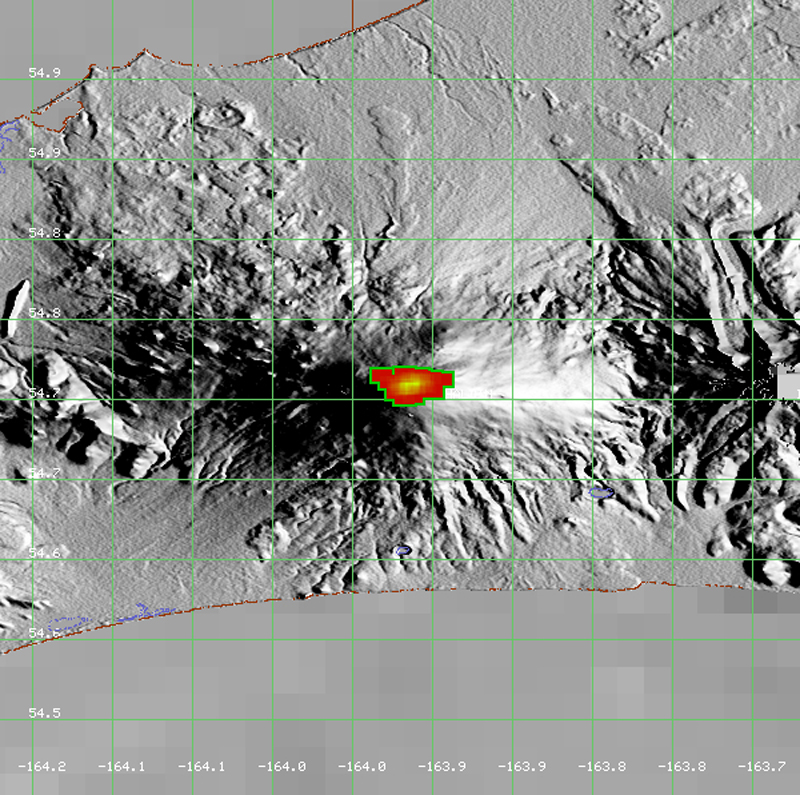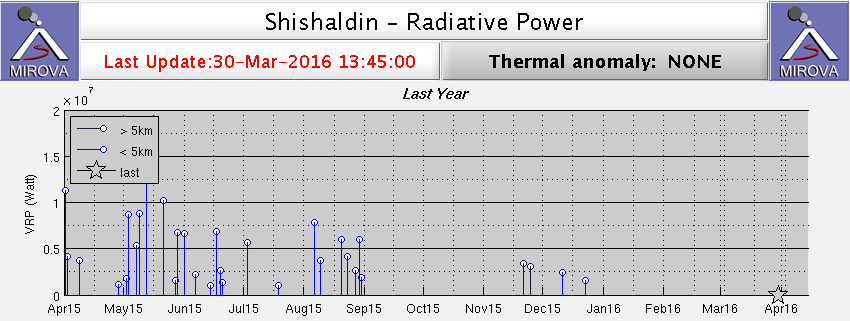Report on Shishaldin (United States) — November 2016
Bulletin of the Global Volcanism Network, vol. 41, no. 11 (November 2016)
Managing Editor: Edward Venzke.
Research and preparation by Robert Andrews.
Shishaldin (United States) Intermittent steam-and-ash plumes and thermal anomalies observed through October 2015
Please cite this report as:
Global Volcanism Program, 2016. Report on Shishaldin (United States) (Venzke, E., ed.). Bulletin of the Global Volcanism Network, 41:11. Smithsonian Institution. https://doi.org/10.5479/si.GVP.BGVN201611-311360
Shishaldin
United States
54.756°N, 163.97°W; summit elev. 2857 m
All times are local (unless otherwise noted)
An eruption at Shishaldin that began in January 2014 was continuing as of March 2015 (BGVN 40:01). The Alaska Volcano Observatory reported increased activity on 28 January 2014 and a low-level lava eruption in the summit crater in mid-March. Thermal anomalies detected by MODIS (Moderate Resolution Imaging Spectroradiometer) satellite sensors first appeared on 30 January, but became more frequent after 4 May 2014.
Thermal data processed by MODVOLC detected anomalies up to 12 May 2015 (figure 10), but none after that through March 2016. Anomalies determined by MIROVA (Middle InfroRed Observation of Volcanic Activity) showed continuing activity through late August 2015 (figure 11).
The Alaska Volcano Observatory (AVO) reported that from January to November 2015, seismicity continued to be slightly elevated over background levels, indicating that low-level eruptive activity confined to the summit crater continued. Minor steaming from the summit was often observed, and on several dates steam and ash plumes were observed over the summit. During this time, the Aviation Color Code was at Orange and the volcanic Alert Level was at Watch.
No anomalous activity was observed in satellite data after weakly elevated surface temperatures were detected on 16 October 2015. In addition, low-amplitude seismic tremor continued but was likely not indicative of a continuing eruption. The Aviation Color Code was lowered to Yellow and the Volcano Alert Level was lowered to Advisory.
On 10 March 2016, AVO reported that there had been a continual decrease in thermal activity over the past several months; no anomalous activity had been observed in several clear satellite images since 13 January, when moderately elevated surface temperatures were detected. Airwaves generated by low-level explosive degassing had not been detected in infrasound data since 7 February. Low-amplitude seismic tremor was at background levels. In March 2016 the Color Code was lowered to Green and the Alert Level was lowered to Normal.
Geological Summary. The symmetrical glacier-covered Shishaldin in the Aleutian Islands is the westernmost of three large stratovolcanoes in the eastern half of Unimak Island. The Aleuts named the volcano Sisquk, meaning "mountain which points the way when I am lost." Constructed atop an older glacially dissected edifice, it is largely basaltic in composition. Remnants of an older edifice are exposed on the W and NE sides at 1,500-1,800 m elevation. There are over two dozen pyroclastic cones on its NW flank, which is covered by massive aa lava flows. Frequent explosive activity, primarily consisting of Strombolian ash eruptions from the small summit crater, but sometimes producing lava flows, has been recorded since the 18th century. A steam plume often rises from the summit crater.
Information Contacts: Alaska Volcano Observatory (AVO), a cooperative program of a) U.S. Geological Survey, 4200 University Drive, Anchorage, AK 99508-4667 USA (URL: http://www.avo.alaska.edu/), b) Geophysical Institute, University of Alaska, PO Box 757320, Fairbanks, AK 99775-7320, USA, and c) Alaska Division of Geological & Geophysical Surveys, 794 University Ave., Suite 200, Fairbanks, AK 99709, USA (URL: http://www.dggs.alaska.gov/); Anchorage Volcanic Ash Advisory Center (VAAC), Alaska Aviation Weather Unit, NWS NOAA US Dept of Commerce, 6930 Sand Lake Road, Anchorage, AK 99502-1845(URL: http://vaac.arh.noaa.gov/); MIROVA (Middle InfraRed Observation of Volcanic Activity), a collaborative project between the Universities of Turin and Florence (Italy) supported by the Centre for Volcanic Risk of the Italian Civil Protection Department (URL: http://www.mirovaweb.it/); Hawai'i Institute of Geophysics and Planetology (HIGP), MODVOLC Thermal Alerts System, School of Ocean and Earth Science and Technology (SOEST), Univ. of Hawai'i, 2525 Correa Road, Honolulu, HI 96822, USA (URL: http://modis.higp.hawaii.edu/, http://modis.higp.hawaii.edu/)



